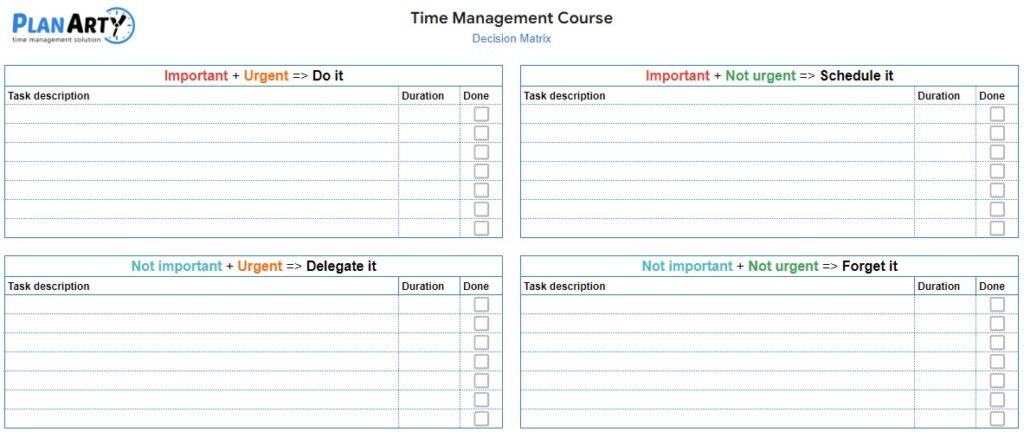Time Management Course
Chapter II
Basic Time Management Concepts

Course structure
DAY 1
Foreword
Study tips
Course schedule (proposal)
Workload Estimator
Daily Worksheet
Resources
DAY 2
Introductory notes
Module 1 – Goal setting
The importance of setting goals
Goals and objectives
Make your goals S.M.A.R.T.
Weekly goals
Practice materials
Decision matrix
How to use the decision matrix
Practice materials
DAY 3
To-do list
Calendar
Someday tasks
Practice materials
DAY 4
Time blocking
SWDH
Practice materials
DAY 5
What time should you be tracking?
Time tracking process
Invoicing your billable hours
Module 6 – Time accountability
Use the calendar to keep yourself on track
Keep track of your daily routine
Leave no task behind
Practice materials
DAY 6
Efficient versus effective
To bear in mind / follow
To avoid
Additional materials
DAY 7
A quick recap of key concepts
Self-Assessment
Additional resources
Introductory notes: The importance of doing the right things at the right time
Sometimes the importance of the concept of “doing the right things at the right time” can be overlooked, but we’ll show you why we should take it into account.
In any situation, it is important to follow a certain course. Otherwise, we risk obtaining a completely different result than the desired one. This can happen even if we know what we have to do and that each of the respective things is absolutely necessary to achieve the result we want.
For example, let’s think of something simple, like preparing a barbecue.
There are a few steps to take in this regard, and each one is as important as the order in which we go through them.
- Season the items that we want to cook on the grill.
- Light the fire and, when the embers are done, add the coals.
- Place the products on the grill and cook them on both sides until they are done exactly as we want.
This way, we will enjoy a delicious barbecue!
But what would be the result of our actions if we proceeded in the following way?
- We do the right things but at the wrong time.
We light the fire, and after the embers are ready, we add the coals. When everything reaches the right temperature, we get in the car and go to the supermarket to buy the products to put on the grill. - We work at the right time but do the wrong things.
That is, in step 1 we take care of the products we want to cook, but we put them in the freezer (instead of seasoning them), or in step 2 we make the fire and add the coals, but we do this before we have well-heated embers.
The outcome? In both situations, it will be totally different from what would be called a delicious barbecue.
Similarly, in any situation, and whatever the goal we have set for ourselves, it is of the utmost importance to do the right things at the right time. That is exactly what you will learn in this course.
Moreover, at the end, you will know how to manage your time in an efficient and effective manner. That is, you will know how to do, in the right way, the right things that help you achieve your goals.
Module 1 – Goal setting
The importance of setting goals
Whenever you want to achieve something, it is advisable to set goals. For example, let’s think about how things went when you just thought:
“I wish I had more time to do all the things I want to do.”
What happened and what did you get as a result?
– Most likely, nothing happened and things went the same way as before, because at that time you did nothing but express a wish.
But the fact that you are here now means something has changed. Most likely, it is the fact that you set out to become better at managing your time – more precisely, you made it a goal.
In this module, you will learn to set goals and, especially, how to set them so that everything that follows will help you achieve them exactly when and how you set out.
Goals and objectives
The first thing to do in this regard is to set goals for everything you want to achieve. Afterward, set and use objectives to fulfill them.
To understand the two notions in this context, think of Goals as the final destination that you have set for yourself in a certain respect and of Objectives as intermediate milestones that you must reach on your way to that destination.
The objectives are the ones that will help you stay on the right track and on time. In this way, they will directly contribute to the achievement of your goals.
Example: Setting a goal and related objectives
As an example, regarding the improvement of time management skills, you could establish the following:
Goal: Improving time management
Objectives:
- Documenting the subject
- Doing a course on this topic
- Applying what I have learned in practice and improving my time management skills
Notice that all the objectives converge towards the fulfillment of the established goal, and their completion in that order can help achieve it. If you stop or change direction after completing the objective from point 2, you will most likely not reach your goal, or at least not when you set out to do so.
Make your goals and objectives S.M.A.R.T.
The acronym S.M.A.R.T. defines the following characteristics for goals and objectives:
Specific: straightforwardly defined, precise and unambiguous; or Strategic, Specific;
Measurable: with specific points of reference that measure whether you are progressing; or Motivating;
Achievable: can be successfully reached; or Agreed, Attainable;
Relevant: with certain importance to your purpose; or Resourced, Reasonable, Results-based;
Timely: a defined timeline for completion; or Trackable, Time-based, Time/cost limited, Testable.
To easily establish S.M.A.R.T. goals and objectives, look at them through the prism of the following questions and characteristics:
What you get by establishing S.M.A.R.T. goals and objectives
You make sure from the very beginning that you will complete everything you set out to do!
A S.M.A.R.T. goal is one that helps you clearly establish what result you want to reach, and S.M.A.R.T. objectives are ones that help you in three ways, namely:
- Accurately identify the steps you have to take to achieve your proposed goal;
- Make sure that you stay on track by easily focusing on meeting the established milestones within the established time frame;
- Benefit from step-by-step motivational support. Any achievement is a very strong motivator. Therefore, every time you tick off an objective as achieved, you will realize that you are constantly moving towards the fulfillment of your goal. That will help you keep going with greater enthusiasm.
Weekly goals
For increased efficiency, we recommend setting weekly goals. This means that at the end of each week you determine the goals you want to achieve in the following week and the objectives related to them.
Example: Setting a weekly SMART goal and related SMART objectives
For a very clear example, we will take into account our proposed course schedule, which was designed so that the course is taken over seven days.
Therefore, we have decided that the goal of the following week is the completion of this course, and we establish the objectives to fulfill in this regard. The following will result from these:Weekly Goal: Completing the Time-Management Course
Objectives for this weekly goal:
- Day 1. Becoming familiar with the notions of time management
- Day 2. Learn about goal setting and prioritization
- Day 3. Discover basic planning
- Day 4. Deepen planning with some advanced techniques
- Day 5. Learn about time tracking and time accountability
- Day 6. Find out how to achieve efficiently effective time management
- Day 7. Final recap and concepts reinforcement
Now let’s analyze both the goal and the objectives established above, from a S.M.A.R.T. point of view, respecting the characteristics and answering the questions listed previously.
Now you are equipped with the knowledge and skills necessary to create and implement SMART Goals and Objectives, which will help you achieve your desired outcomes.
We recommend that you practice passing your goals and objectives a few times through the filter of the questions and features presented in this module. You can try to do this with the goals you set for the immediately following periods, for example, tomorrow or next week.
As you practice, you will find that each exercise becomes more effortless, and you will gradually transition into a more natural flow.
Practice materials for Chapter II, Module 1 – Goal setting
To provide you with a practical example we’ve created an Excel template that walks you through setting SMART Goals and Objectives.
This template even includes a “Possible issues” section, to help you identify any potential challenges that could get in your way. By anticipating these roadblocks, you can take steps to overcome them and stay on track to achieving your goals.
The sample form is filled out with the goal of “Improving time management” to give you an idea of what to include.
To practice, fill out the form with your own goal and specific information, in the area highlighted in this color.
Module 2 – Prioritization
Prioritization is a highly important element in time management because it will help you focus your efforts specifically in the desired direction.
Once you have established your goal and objectives, you will know exactly what you want to achieve and what you have to do to reach that result. However, apart from those activities, you likely have many other things to do.
If you will do things by chance or as they come, you risk consuming time and energy with activities that do not serve your goal or that might even take you away from it.
Precisely for this reason, you must determine what exactly will occupy your time and, of course, in what order.
For this, you have at hand a very simple and proven effective tool, namely, the decision matrix, also called the Eisenhower matrix or the urgent important matrix
Decision matrix
In this matrix, activities are prioritized according to their importance and urgency, though they are viewed through the prism of the impact they have on achieving the goal you have proposed.
How to use the decision matrix
Start from the following basic considerations:
- Important are those activities that lead you to fulfill your purpose, both professionally and personally;
- Urgent are those activities that require immediate action and come with clear consequences for not completing them; however, keep in mind that they do not always have something to do with achieving the proposed goal.
- Important and urgent: You will perform these tasks immediately.
Examples of activities that fall here are meetings, crises, client problems, health emergencies, last-minute deadlines, projects, and pressing problems. - Important but not urgent: You will schedule these tasks to perform them later.
Examples of activities that fall here are planning, building relationships, regular chores, personal growth, learning, and professional networking. - Not important but urgent: As much as possible, delegate these tasks to someone else.
Examples of activities that fall here are some phone calls or emails, interruptions by colleagues or family members, some requests, and irrelevant meetings. - Not important and not urgent: You can quit doing these activities.
Examples of activities that fall here are games, social media, internet, TV, and coffee breaks.
Free download: Decision Matrix template on different formats
- Google Sheets
- Microsoft Excel workbook
- Word
- Printable




